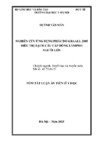
Please use this identifier to cite or link to this item:
http://dulieuso.hmu.edu.vn/handle/hmu/1736| Title: | Nghiên cứu ứng dụng phác đồ GRAALL 2005 điều trị bạch cầu cấp dòng lympho người lớn |
| Authors: | Huỳnh Văn, Mẫn |
| Advisor: | PGS.TS. Nguyễn Hà, Thanh |
| Keywords: | 62720151;Huyết học và truyền máu |
| Abstract: | THÔNG TIN TÓM TẮT NHỮNG KẾT LUẬN MỚI. CỦA LUẬN ÁN TIẾN SĨ. Những kết luận mới của luận án:. 1. Đặc điểm bệnh nhân: tuổi trung bình là 35 tuổi, nam chiếm 53%, biểu hiện lâm sàng chủ yếu là thiếu máu, sốt, xuất huyết, gan, lách hay hạch to. Tỉ lệ BCCDL B là 71,7%, tỉ lệ BCCDL có Ph+ là 33,3%. Tỉ lệ bệnh nhân có tế bào non ác tính trong dịch não tủy lúc chẩn đoán là 3,3%.. 2. Kết quả điều trị: tỉ lệ lui bệnh sau tấn công là 91,7%, tỉ lệ lui bệnh kể cả điều trị cứu vớt là 95%. Tỉ lệ sống không bệnh và sống toàn bộ sau 3 năm lần lượt là 41%và 49%. Thời gian sống không bệnh và toàn bộ trung bình lần lượt là 32,3 tháng và 35,6 tháng.. Chưa phát hiện thấy các yếu tố giới tính, gan lách to, tăng men gan, acide uric, LDH, hình thái tế bào, dấu ấn miễn dịch, dịch não tủy ảnh hưởng đến kết quả điều trị tấn công và thời gian sống.. Phát hiện thấy một số yếu tố có ảnh hưởng đến thời gian sống đó là: số lượng bạch cầu >30x109/L, trên 30 tuổi, MRD sau tấn công >0,1% có thời gian sống ngắn hơn những bệnh nhân có bạch cầu <30x109/L, dưới 30 tuổi, và MRD < 0,01%.. 3. Biến chứng và độc tính:độc tính trong giai đoạn tấn côngchủ yếu là trên huyết học (72-100%), nhiễm trùng (84,5-100%), độc tính trên gan (37,5-50%), tăng đường huyết (5-45%), loét niêm mạc (17,5-60%). Độc tính trong giai đoạn sau tấn công bao gồm độc tính trên huyết học (53-95%), nhiễm trùng (40-85%), độc tính trên gan (27,5-45%), tăng đường huyết (14,7-50%), loét niêm mạc (29,7-55%).. . SUMMARY THE NEW CONCLUSION OF THE THESIS. The new conclusions of the trial:. 1. Characteristics of patients:mean age 35 years, 53% male, clinical manifestations mainly anemia, fever, bleeding, liver, spleen, or lymphadenopathy. The rate of B- ALL was 71.7% and Ph+ALL was 33.3%. The proportion of patients with blasts in the CSF at diagnosis was 3.3%.. 2. Results of treatment:remission rate was 91.7% after the induction, the rate of remission including salvage therapy was 95%. The rate of disease-free survival and overall survival after 3 years were 41% and 49%, respectively. Disease-free survival time and overall survival average were 32.3 months and 35.6 months, respectively.. Never found the sex, splenomegaly, elevated liver enzymes, uric acid, LDH, cell morphology, immune markers, CSF affect complete remission and survival time.. Found a number of factors that affect survival time were: WBC count> 30x109/ L, 30 years old, MRD> 0.1% had a shorter survival time compare to patients with WBC <30x109/ L, under 30, and MRD <0.01%.. 3. Complications and toxicity:toxicity in induction phase mainly on hematology (72-100%), infection (84.5 to 100%), hepatotoxicity (37.5 to 50%), hyperglycemia (5-45%), mucosal ulcers (17.5 to 60%). Toxicity in the consolidation including hematologic toxicity (53-95%), infection (40-85%), hepatotoxicity (27.5 to 45%), hyperglycemia (14, 7-50%), mucosal ulcers (29.7 to 55%).. |
| URI: | http://dulieuso.hmu.edu.vn//handle/hmu/1736 |
| Appears in Collections: | Luận án (nghiên cứu sinh) |
Files in This Item:
| File | Description | Size | Format | |
|---|---|---|---|---|
| 108_LA- Man.pdf Restricted Access | 3.11 MB | Adobe PDF |  Sign in to read | |
| 108_24- Man.pdf Restricted Access | 1.33 MB | Adobe PDF |  Sign in to read |
Items in DSpace are protected by copyright, with all rights reserved, unless otherwise indicated.